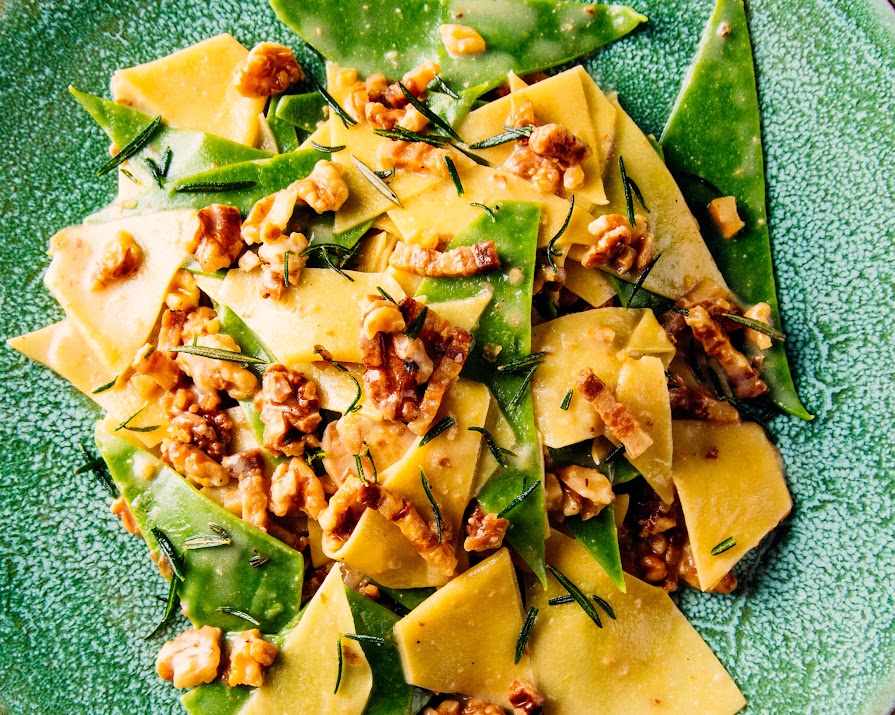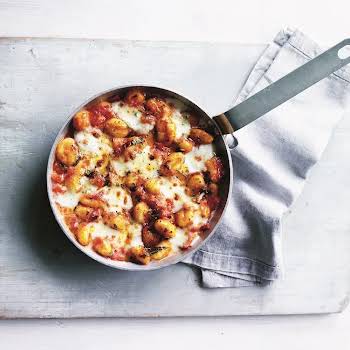By Meg Walker
29th Mar 2020
29th Mar 2020
Jeda is, essentially, a walnut and garlic pesto that’s a staple of la cucina povera – poor people’s cooking – in the Apennine Mountains that border southern Bologna. Some versions throw in boiled potatoes, which were a welcome addition for the hungry peasants working the fields; they needed every last morsel and calorie they could get. I prefer a lighter approach, so I omit them.
Maltagliati con “Jeda”
Maltagliati with Walnut Pesto
Serves 6
Ingredients
240g walnut halves
2 garlic cloves
150g pancetta, cut into 6mm batons
1 sprig fresh rosemary
kosher salt
1 recipe maltagliati (see recipe below)
150g finely grated parmigiano-reggiano
Method
Preheat the oven to 150°C/gas mark 2. Line a baking sheet with parchment paper.
Spread the walnuts evenly over the prepared baking sheet and toast until mahogany coloured, about 10 minutes. Transfer to the bowl of a food processor, add the garlic, and pulse until the walnuts are the size of peas, about 1 minute.
In a large pan over medium heat, cook the pancetta, stirring occasionally, until crispy and the fat has rendered, about 3 minutes. Fry the whole sprig of rosemary in the rendered fat until fragrant, about 30 seconds. Remove to a plate and set aside to cool, then pick the leaves and set aside. Discard the stem. Stir the walnut mixture into the rendered fat in the pan. Set the sauce aside.
Bring a large pot of water to a rolling boil over high heat. Season the water with salt. When the salt dissolves, add the maltagliati and stir to separate the pieces. Cook until tender, about 2 minutes.
Meanwhile, return the sauce to medium heat. Using a spider, transfer the pasta and a splash of the pasta cooking water to the sauce. Stir vigorously to emulsify. Add additional pasta cooking water, as needed, to loosen the sauce. Stir in 50g of the Parmigiano-Reggiano and serve immediately with the remaining Parmigiano-Reggiano sprinkled on top. Garnish with the rosemary.
To make the pasta…
Sfoglia All’Uovo
Egg Dough
Makes two 355g pasta dough balls, serving 6
Ingredients
454g “00” flour, plus more for dusting
258g eggs, beaten
MAKE THE PASTA DOUGH: Sift the flour onto your work surface and make a 20cm diameter well in the centre. You should be able to see the work surface in the middle and the well’s walls should be high enough to contain the eggs.
Pour the eggs into the well. Working from the interior edge of the well, use a fork to incorporate a bit of the flour with the eggs. Continue incorporating a bit of flour at a time until the dough is the consistency of pancake batter. Clean off any flour mixture stuck to the fork and add it to the dough. Using a bench scraper, scrape any remaining flour from the work surface into the dough. Working in a clockwise motion, cut the dough together as though you are making biscuits: scrape, fold, and cut. Continue working the dough until a shaggy mass forms, 2 to 3 minutes. Parts of the mass will be rather wet, while other parts will be floury. Scrape any dough from the bench scraper into the mass.
KNEAD THE PASTA DOUGH: With both hands, pull the far end of the dough toward you quickly and energetically, fold it over itself, then push it away from you using the heels of your palms. Rotate the dough a quarter turn and repeat the kneading for 3 to 5 minutes until the dough is a compact mass. The dough will be slightly tacky.
Using the bench scraper, scrape any dry bits of dough from your work surface and discard. Wash, but do not dry, your hands and continue kneading the dough as before until it is relatively smooth with a cellulite-like texture, an indication of gluten formation, 3 to 5 minutes more. Wrap the dough tightly in plastic wrap, seam-side up, and smooth out any air pockets. Set aside to rest at room temperature for 15 minutes.
SHAPE THE PASTA DOUGH: Unwrap the dough. Halve it with a sharp knife, cutting in a sawing motion. On a lightly floured surface, knead one piece of dough energetically with both hands, anchoring the dough with your non-dominant hand as you pull the far end of the dough toward you, then press down, through, and away, with your dominant hand. Turn the dough counterclockwise using your non-dominant hand, moving it as you knead in 2.5 to 5cm increments, like the hour markings on a clock. If the dough feels too dry, spray it and your hands with water, a little at a time, until it loses its dryness. If you are closing the round ball and find the folded end (or back door) is not sealing, spray that with a touch of water to help it along. Continue kneading until the dough is soft and smooth all the way around, 3 to 5 minutes. Repeat with the second piece of dough. Place each dough ball in the middle of its own piece of plastic wrap measuring about 30.5cm square. Working with one ball at a time, pull one corner of the plastic wrap up and lay it over the ball. Then, turning and rotating as you go, make 15 to 20 tiny pleated folds of plastic, almost like a candy wrapper, until the ball is fully and tightly sealed. The plastic wrap will follow the contour of the dough, which will create even pressure and support from all sides and prevent a flat surface or hard edge from developing when wrapping the dough. Set the dough balls aside to rest at room temperature for 2 to 3 hours or up to 24 hours in the refrigerator before rolling.
The dough will keep, refrigerated and tightly wrapped in plastic wrap, for up to 2 days. Do not freeze it. Before rolling, set the wrapped dough on the counter and let it come to room temperature, about 30 minutes. This is a must for refrigerated egg doughs.
Roll one dough ball to a thickness of 9 Post-it® Notes on a lightly floured work surface. Cure the sfoglia. Fold the sfoglia in half, press gently along the crease, and unfold. Using a sharp knife, cut the sfoglia along the crease. Position the half-moon-shaped pieces of sfoglia with the round ends closest to you and the cut ends facing away from you. Starting at the round edge of one sfoglia crescent, fold the pasta 7.5cm over and continue to fold until you have a loose roll. Repeat with the remaining dough. Beginning at the end of one roll, using a sharp knife, cut the dough into 2.5cm thick strips. Cut each strip 2.5cm diagonally. Repeat with the remaining dough.
Using both hands, gather up the dough pieces and gently toss them to separate the pieces, setting them down on a clean work surface. The maltagliati are ready to use now, or you can dry them for future use: Set aside on a wooden surface, at room temperature, until completely dry, 2 to 3 hours. You can expedite the drying process by placing a fan near the pasta, avoiding direct air.
Meanwhile, repeat the process with the remaining dough ball.
The dried pasta will keep, at room temperature in an airtight container, for up to 2 weeks or frozen for up to 6 months.

Extracted from American Sfoglino by Evan Funke with Katie Parla (Chronicle Books, approx €28.50). Photography by Eric Wolfinger.























